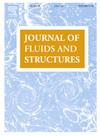振动5:1矩形圆柱在光滑和湍流中的气动力和气动弹性研究
IF 3.5
2区 工程技术
Q1 ENGINEERING, MECHANICAL
引用次数: 0
摘要
通过单自由度(SDOF)垂直/扭转强迫振动风洞试验,研究了在光滑和湍流中振动5:1矩形圆柱的气动力。它量化了相对于降低的风速和振幅,气动力的不同组成部分的能量贡献。强调了湍流在抑制规则涡脱落方面的关键作用,以及它对流体记忆效应和气动力系数的修正作用。揭示了自激矩与扭转运动之间的相位差对单自由度扭转保守系统气动弹性稳定性的决定性作用。提取振幅相关的颤振导数,显示出明显的湍流效应,从而导致流体与自激力之间的传递发生显著变化。分析了垂直扭转耦合系统的气动弹性响应,揭示了湍流引起的气动弹性稳定性变化主要是由于非耦合气动阻尼的变化。在一定的风速范围内,系统的气动弹性稳定性和稳定极限环振荡(LCO)幅值均比平稳流动时有所提高。然而,在高风速下,响应转变为硬颤振,而在光滑流场中,通常表现为具有稳定LCO的软颤振。本文章由计算机程序翻译,如有差异,请以英文原文为准。
Study on aerodynamic forces and aeroelasticity of an oscillating 5:1 rectangular cylinder in smooth and turbulent flow
This study examines the aerodynamic forces on an oscillating 5:1 rectangular cylinder in smooth and turbulent flow by single-degree-of-freedom (SDOF) vertical/torsional forced vibration wind tunnel tests. It quantifies the energy contributions of different components of aerodynamic forces with respect to reduced wind speed and amplitude. The critical role of turbulence in suppressing regular vortex shedding is highlighted, along with its modifying effect on fluid memory effects and aerodynamic force coefficients. The decisive role of the phase difference between self-excited-moment and torsional motion on the aeroelastic stability of an SDOF torsional conservative system is revealed. The amplitude-dependent flutter derivatives were extracted, showing significant turbulence effects and thereby notable changes in the transmission between fluid and self-excited forces. The aeroelastic response of a vertical-torsional coupled system was analyzed, revealing that turbulence-induced variations in aeroelastic stability are primarily due to changes in uncoupled aerodynamic damping. Compared to a smooth flow, the system exhibits an enhanced aeroelastic stability and smaller stable limit cycle oscillation (LCO) amplitudes within a certain wind speed range under turbulent flows. However, at high wind speeds, the response transitions to hard flutter, whereas in a smooth flow field, it generally manifests as soft flutter with stable LCO.
求助全文
通过发布文献求助,成功后即可免费获取论文全文。
去求助
来源期刊

Journal of Fluids and Structures
工程技术-工程:机械
CiteScore
6.90
自引率
8.30%
发文量
173
审稿时长
65 days
期刊介绍:
The Journal of Fluids and Structures serves as a focal point and a forum for the exchange of ideas, for the many kinds of specialists and practitioners concerned with fluid–structure interactions and the dynamics of systems related thereto, in any field. One of its aims is to foster the cross–fertilization of ideas, methods and techniques in the various disciplines involved.
The journal publishes papers that present original and significant contributions on all aspects of the mechanical interactions between fluids and solids, regardless of scale.
 求助内容:
求助内容: 应助结果提醒方式:
应助结果提醒方式:


